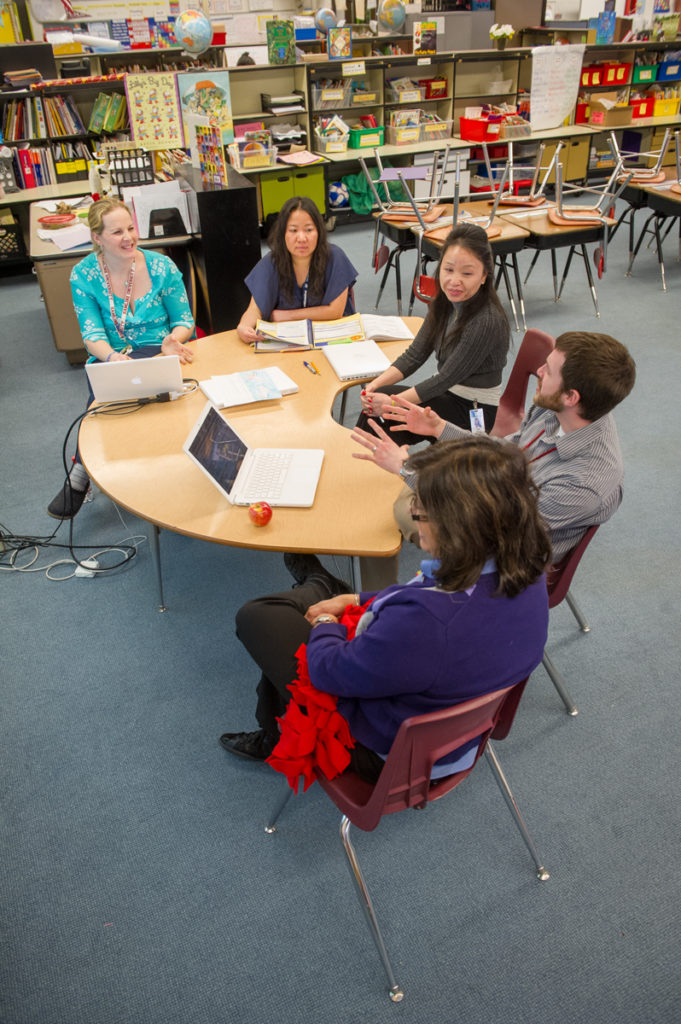
A recently completed three-year study conducted by the University of Virginia’s Curry School of Education and funded by the U.S. Department of Education looked at whether the Responsive Classroom approach improves student outcomes and if so, how it does so. Specifically, the Responsive Classroom Efficacy Study considered whether the approach improves student achievement as measured by standardized math and reading tests.
When teachers use Responsive Classroom practices, student achievement does indeed improve.
As part of the study, the researchers asked thirty-three third grade teachers what motivates them to use Responsive Classroom practices. The teachers reported that buy-in by their principal plays an important role. When objective observers noted that principals in particular schools were strong in their Responsive Classroom support, teachers in those schools were indeed more likely to use the approach, and the quality of their implementation was higher.
Teachers told the researchers they feel encouraged when their administrators demonstrate a genuine belief in Responsive Classroom principles and interest in using the approach to improve outcomes for children. As Steve Crump, principal at Sarasota Suncoast Academy, a public charter school in Sarasota, Florida, puts it, “It’s about the kids. The school’s not my school. The school’s the students’ school. Without the kids, we wouldn’t have a school. So when we use Responsive Classroom practices such as rule making, we look at how we can guide the process so it results in rules that are student-centered, that help them take ownership.”
Pennsylvania teacher Cindy Kruse (who is also a Responsive Classroom consulting teacher) notes the importance of support like Crump’s in Rainbow Elementary School’s implementation, which began in 2007. “The principal, the vice principal—they came through the whole training, which I thought was really advantageous.” Kruse concludes that “if you’re going to ask teachers to do this, you need to be able to support them in lots of ways besides getting funding. . . . Leadership does come from the administration, and that’s why I think it’s important that they go through the whole training and that they’re behind it 100 percent.”
According to the study, teachers are also more motivated to use Responsive Classroom practices in their own classrooms when the principal and other school adults are also using the practices with children every day. When Karen Casto was principal at Penn Valley Elementary School in Levittown, Pennsylvania, she arranged training for every teacher. And she had not only paraprofessionals but also, as much as possible, custodians, secretaries, and other school adults attend Morning Meetings. “Myself, counselors,” Casto says, “we were all in Morning Meetings; that’s how we started our day.”
A principal’s support for schoolwide use of all the practices, rather than just a few, also motivates teachers. Maureen Marshall, principal at Garfield Elementary School in Springfield, Virginia, takes that broad view of implementing the approach. “It really is a whole philosophy,” she says. “We don’t need to worry about whether we’re giving the kids what they need because we know that Responsive Classroom is the whole package.”
Principals also make a difference by making sure teachers have the resources they need. Cindy Kruse from Rainbow Elementary observes that her principal and vice-principal were great at that. “They bought charts and chart paper and chimes. . . .” The administrators, says Kruse, knew that providing resources not only enables teachers to implement the Responsive Classroom approach properly but also lets them “know you’re going to support them in small ways, too. It makes a big difference.”
Giving teachers time to implement Responsive Classroom practices matters, too. That means not only providing time to use the practices (such as by adding slots to the master schedule for Morning Meeting), but providing plenty of time to learn the practices. Karen Casto notes that “if we expect teachers to have these practices down in a year, we’re setting them up to fail. There’s so much that teachers have to do, and with all the pressure for testing and all the other mandates that are coming down, I think we have to be mindful of how to help teachers incorporate Responsive Classroom into their daily practice and not to overwhelm them.”
Many factors influence schools’ success in implementing the Responsive Classroom approach. But these early research results confirm what many educators have observed over many years: What school leaders believe, say, and do truly matters. And when the goal is schoolwide implementation of the Responsive Classroom approach, principal support will help teachers find the path and follow it to success.